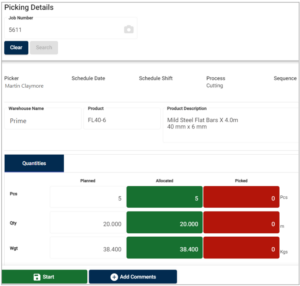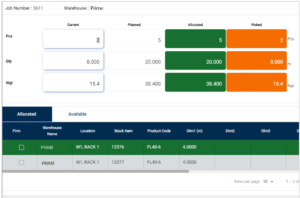Overview
The iMetal 4.6 version has introduced new features for the mobile application suite, such as the ability to search stock items, to perform stock takes and location audits, to update details for stock items, and to use mobile devices in picking and moving stock items.
The non-traceable stock logic in iMetal has been enhanced to allow non-traceable stock items to be merged based on Attributes as well as product, dimensions, location, etc. It will be possible to add restocking charges to the credit notes. The buyers will be able to enter the order quantity to be released and release date given by the mills and other suppliers. Also, the changes in due date, quantity, price, cost, dimensions etc. in the purchase order items will be highlighted so that the other members of the procurement team can see which items have been amended.
Non-traceable stock management
In traceable stock logic, each stock received into inventory as a result of Goods Inwards or Production Processes has a unique stock item number (or tag) assigned to it. If the dimensions and/or quantity of the stock item is changed due to a production process, then a new stock number is assigned to each output of the process. As a result, the original stock item number decays into two new stock item numbers and each new stock item has a reference to the parent stock item number, therefore it is possible to trace the final stock item number back to the original stock item.
However, in non-traceable logic, each stock item does not have a unique number. Instead, the stocks with the same product code, same dimensions and same attributes are grouped or merged together as a single stock item. If a quantity of stocks from this group is used or processed, the system does not assign a new stock number to the remaining group. If the output of the process matches with the new size and dimensions matches to another group with the same product code and dimensions, then it will be added to this group, and the quantity and/or pieces will increase in the group.
The non-traceable logic can be activated at the product category level.
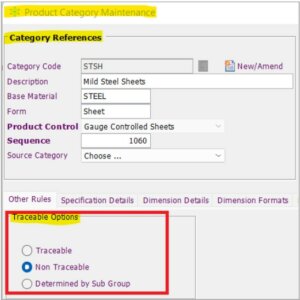
The additional attributes used for grouping and merging the stock items as part of non-traceable logic are also defined at the product category level.

Stock dimension summary by attributes
The new feature allows the stock dimension summary enquiry to summarise stock items, incoming items, allocations etc. by using attributes that are specified as Summary Grouping Attributes. Summary Grouping Attributes are defined at Product Category level.
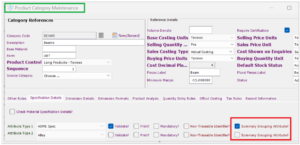
Based on the grouping attributes, the view on the application Stock Dimension Summary Panel can be changed to include those attributes (i.e. specifications) as columns. In the application, the aggregated quantity values are displayed.
Highlighting amended purchase order lines
If the organisation creates purchase orders with tens or even hundreds of items, and if a procurement personnel makes a change in one of the items, it would be difficult for other personnel such as order reviewers and approvers to identify which item or items have been amended.
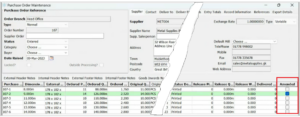
This problem has been addressed by this new feature. When configured to track amended purchase order items, if an item in purchase order, which is printed and released, is amended by a user, then the flag “Amended” for the order item is checked out and the row colour of the order item turns light green.
Until the “Amended” flag is reset, the order item will appear as highlighted in Purchase Order Entry and Purchase Order Item Inquiry screens.
Restocking charge in credit notes
When customers return materials and are credited for sales invoices, the companies may charge them a restocking charge to cover the cost of picking the material back and any associated administration costs. Restocking charges will reduce the amount to be credited to the customer. The restocking charge is a charge to be used in the credit note and is not necessarily linked to the sales group of the original sales item. It can be posted to a separate account code in the general ledger.
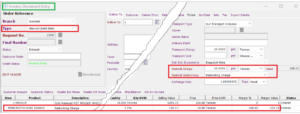 The restocking charge can be entered against the Credit Notes. It can be defined as a lump sum amount, or a charge can be entered against the unit selected. For example, if the unit Tonnes is selected, then the total weight is found in Tonnes, and total restocking charge is calculated for the total weight.
The restocking charge can be entered against the Credit Notes. It can be defined as a lump sum amount, or a charge can be entered against the unit selected. For example, if the unit Tonnes is selected, then the total weight is found in Tonnes, and total restocking charge is calculated for the total weight.
The restocking charge is added to the credit note as a separate line.
Purchase Order Releases
Some large multi-branch organisations may have centralised their procurement, and ask for quotes from various mills and suppliers in order to get better prices, favourable payment terms, and delivery schedule. Such companies may negotiate the product releases against the individual purchase order items.
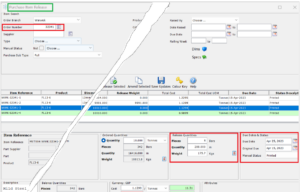
As a result of such negotiations, the buyers in the organisation would need to enter the release quantity, weight and release date provided by the suppliers and mills in order to inform the branches which placed the order.
Searching and locating stock items
The feature will enable shop-floor and warehouse operators to search and locate the stock item by entering the stock item number or scanning the stock item barcode, and view their details on the smart mobile devices. Searching for stock items can be performed by scanning barcodes for stock items or locations, or entering product code. The detail of the stock can be viewed by clicking on the button “View Details”.

Printing stock item details
The details of a stock item includes the stock item number, product code, description, status, received date, warehouse, mill name, cast number, location, dimension and quantity values.

The label can also printed for the stock item can also be printed.
Live stock taking
The feature will enable warehouse operators to perform live stock taking for a given stock-take sheet, and location audits to update the stock items found in a given location.
In the stock take, the operators select the stock-take she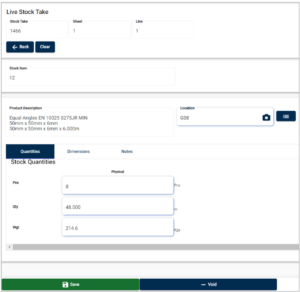 ets, scan the stock items, confirm the quantities and add comments if/where needed.
ets, scan the stock items, confirm the quantities and add comments if/where needed.
Location audit
In location audits, the operators will select the location or scan the location barcode, and scan the barcodes of the stock items found in the location. Effectively, location audits are the stock-takes at location level.
Stock item move and adjustments
The operators will be able to update the location of the stock item if it is moved to a new location, or it is found in another location, which is different from the location in the system.
Also, the operators will be able to adjust the quantity figures of the stock item if the actual figures are different from those stored in the system.
Picking and moving stock items
The picking operators will be able to locate the stock items to pick and move by working through the travel cards.
The operator can register how much of the allocated product has been picked. If the allocated quantity is partially picked or over picked, then the column “Picked” will be in Amber colour.
When the operator picks the full quantity required for the job, then the system will suggest completing the job and start the new picking task.
